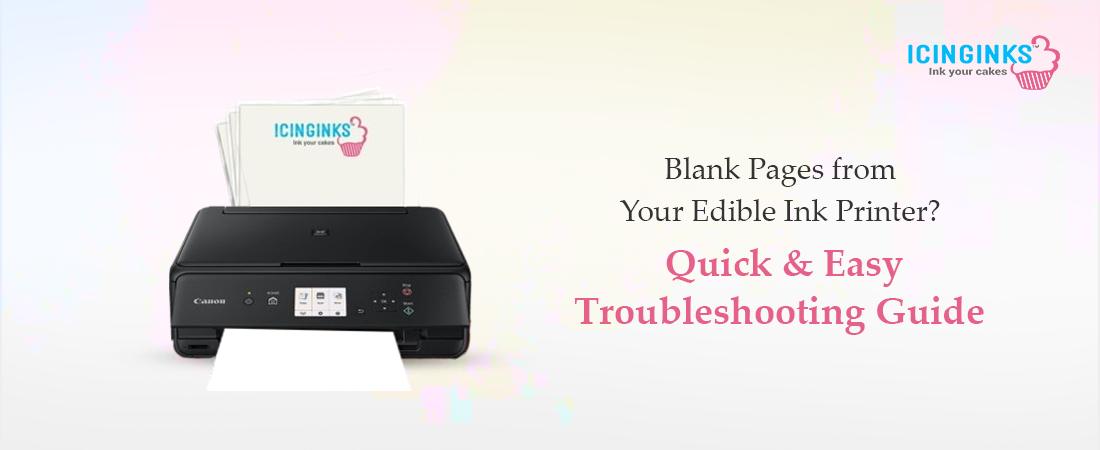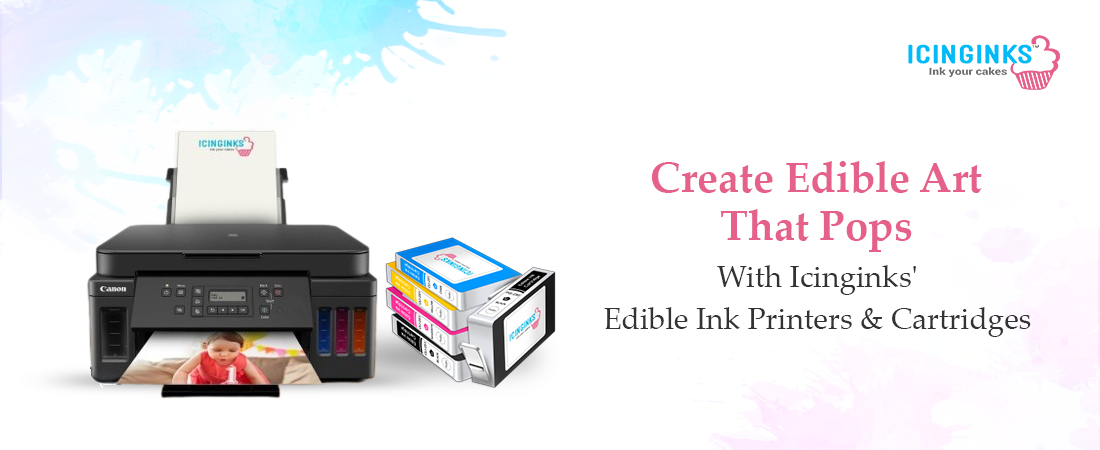
If your edible ink printer is spitting out blank pages, don’t panic just yet. It can be frustrating, especially when working on custom cake toppers or personalized cookies, but the issue is often fixable. There are several reasons why this may be happening, from minor clogs to cartridge misplacements. In this guide, we’ll walk you through the most common causes and step-by-step solutions to get your printer back in action.
1. Check Your Edible Ink Cartridges
A. Are They Properly Installed?
An improperly seated ink cartridge is one of the most common reasons an edible ink printer may print blank pages. Remove each cartridge and reinsert it until you hear a click or feel it lock into place. Make sure each color is inserted into its correct slot.
B. Is There Enough Ink?
Sometimes the cartridge appears full but is empty or dried out. Check ink levels through your printer software or gently shaking the cartridge to feel for liquid movement. Replace any depleted or expired cartridges.
2. Clean the Print Head
A. Why Cleaning Is Crucial
The print head transfers ink onto the wafer paper or frosting sheets. When ink dries up or clogs, your printer can’t print properly, even if your cartridges are full.
B. Manual vs. Automatic Cleaning
Most printers offer an automatic head-cleaning function through the settings menu. If that doesn’t work, consider removing the print head and cleaning it manually using warm distilled water and a lint-free cloth.
Warning: Never use alcohol or harsh chemicals, as they can damage edible-safe components.
3. Run a Nozzle Check
A. Diagnosing the Issue
Before further troubleshooting, run a nozzle check from your printer’s maintenance settings. This prints a test pattern that shows whether each ink color is flowing properly.
B. Interpreting the Results
- If all colors are missing: Print head or cartridge issue.
- If some colors are missing, specific nozzles will likely clog.
- You may need to repeat the head cleaning if patterns are faded or incomplete.
4. Use Compatible Edible Ink and Paper
A. Edible Ink Cartridge Quality
Low-quality or incompatible cartridges can cause poor printing performance or blockages. Always use branded or manufacturer-recommended edible ink cartridges made specifically for your printer model.
B. Use Proper Media Like Wafer Paper
Wafer paper is one of the most commonly used media for edible printing, but if you're using an uneven or incompatible sheet, it might not feed properly through the printer. Always ensure the paper is flat, dry, and correctly aligned.
5. Update or Reinstall Printer Drivers
A. Outdated Software Can Disrupt Printing
An outdated or corrupted printer driver may result in blank pages. Visit your printer manufacturer’s website and download the latest driver specific to your printer and operating system.
B. How to Reinstall
- Uninstall the current driver from your system.
- Restart your computer.
- Download and install the new driver.
- Reconnect your printer and test.
6. Perform a Deep Cleaning Cycle
A. When to Try This
If regular cleaning cycles haven’t helped, use the deep cleaning option. It uses more ink but pushes it through the nozzles with more force to dislodge clogs.
B. Don’t Overdo It
Performing too many deep cleans in a row can waste ink. If no improvement is seen after 2–3 cycles, it might be time to consider manual print head cleaning or cartridge replacement.
7. Store and Use the Printer Correctly
A. Storage Tips
If you don’t use your edible ink printer regularly, the ink can dry out and clog the nozzles. Always print at least once weekly to keep the ink flowing and prevent drying.
B. Environmental Conditions
Avoid placing your printer in a humid kitchen or near a heat source. Excess moisture or high temperatures can affect ink consistency and wafer paper performance.
8. Try a Test Print on Regular Paper
A. Rule Out Media Issues
Before you blame the hardware, try printing on plain paper using your edible ink cartridges. If it prints fine, the issue might be with your wafer paper or frosting sheet.
B. Adjust Paper Settings
Ensure your printer settings align with the type of paper you're using. Select “High Quality” or “Photo Paper” mode for better results when printing on edible sheets.
9. Reset Your Printer
A. Why Resetting Helps
A factory reset can clear out any software glitches that might be causing your edible ink printer to malfunction.
B. How to Reset
Refer to your printer’s user manual for reset instructions. After the reset, reconnect the device, reinstall drivers, and perform a test print.
10. Still Printing Blank? It Might Be Time for Repairs
A. When All Else Fails
If none of the above solutions work, a hardware issue may be a damaged print head or a faulty ink sensor. Contact the printer manufacturer or a specialized edible printer repair service.
B. Consider Upgrading
If your current edible ink printer is outdated, it may be worth investing in a newer model. Newer printers are more efficient, easier to maintain, and compatible with a wider range of edible products.
Final Thoughts
Dealing with blank pages from your edible ink printer can be stressful, especially when you're working on deadline-driven edible projects. Whether you’re printing on wafer paper or frosting sheets, it’s essential to maintain your equipment and use high-quality edible ink cartridges.
Regular cleaning, proper usage, and following the steps above will help ensure that your edible creations come out just right.
By addressing these common issues and maintaining your printer properly, you can ensure smoother operations and more vibrant results, bite after bite.
Unlock Vibrant Edible Creations with Icinginks' Premium Edible Ink Printers and Cartridges

At Icinginks, we deliver reliable edible printing solutions that bring your creativity to life. Our edible ink printers are built to produce vibrant, detailed prints, perfect for cake toppers, cookies, and edible decorations. Whether you’re a professional baker or a passionate hobbyist, our user-friendly printers ensure smooth and consistent performance.
We also offer high-quality edible ink cartridges that are FDA-compliant, gluten-free, and Kosher-certified, safe for use, and rich in color. Compatible with popular Canon and Epson models, our cartridges always give you peace of mind and outstanding print quality.
We’re committed to supporting you with refillable cartridge options, maintenance kits, and expert guidance to keep your setup running efficiently. When you choose Icinginks, you're choosing trusted quality and dependable service.
Buy Now. Pay Later
Pay in 4 with Sezzle at checkout.
We offer flexible payment plans to fit your budget, so you can start creating without delay.
Explore our range of edible ink printers and cartridges and take your edible art to the next level!
FAQs
1. Why is my edible ink printer printing blank pages?
Blank pages are usually caused by clogged nozzles, dried ink, or improperly installed edible ink cartridges. Sometimes, the printer doesn’t recognize the cartridge, or the settings may be incorrect. Regular maintenance and using high-quality cartridges can help avoid this issue and ensure consistent edible printing performance.
2. How do I unclog the nozzles in an edible ink printer?
To unclog nozzles, run the printer's built-in cleaning cycle first. If that doesn’t work, use a nozzle cleaning solution compatible with edible printers. Gently clean the printhead or soak it in warm distilled water. Avoid using harsh chemicals that may damage edible components.
3. Can using low-quality edible ink cartridges cause printing issues?
Poor-quality edible ink cartridges can lead to clogs, uneven prints, or printer errors. They may contain ink that’s too thick or improperly formulated. Always use reliable, FDA-compliant cartridges from trusted brands like Icinginks to maintain print quality and protect your printer’s components.
4. How often should I clean my edible ink printer?
Clean the printer once a week to prevent clogs and maintain print quality for regular use. If unused for over a few days, run a test print or nozzle check before printing again. Consistent cleaning helps extend your printer’s life and ensures vibrant, edible designs.
5. Is there a difference between edible ink and regular ink cartridges?
Absolutely. Edible ink cartridges are filled with food-safe, FDA-approved ink designed for direct contact with consumables. Regular ink is toxic and not suitable for food use. Always use edible-specific cartridges in your printer to ensure safe, high-quality results on wafer paper or frosting sheets.
Related Post:
Essential Tips for Edible Printer Maintenance – A Must-Read!
How to Improve the Quality of Your Edible Images
Right Ways to Remove Clogging of Edible Printer for Their Better Life
Here’s How You Can Cut Fondant with Cricut in Easiest Steps




